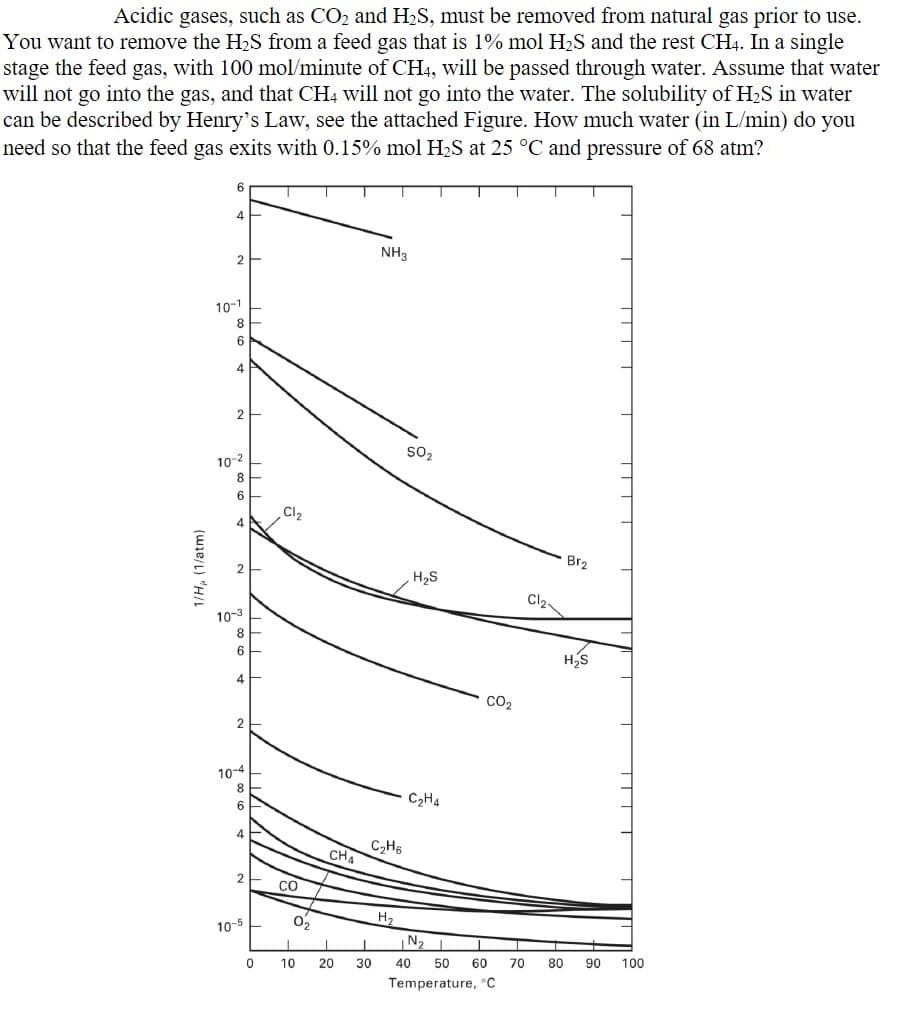Acidic gases, such as CO₂ and H₂S, must be removed from natural gas prior to use. You want to remove the H₂S from a feed gas that is 1% mol H₂S and the rest CH4. In a single stage the feed gas, with 100 mol/minute of CH4, will be passed through water. Assume that water will not go into the gas, and that CH4 will not go into the water. The solubility of H₂S in water can be described by Henry's Law, see the attached Figure. How much water (in L/min) do you need so that the feed gas exits with 0.15% mol H₂S at 25 °C and pressure of 68 atm?
Acidic gases, such as CO₂ and H₂S, must be removed from natural gas prior to use. You want to remove the H₂S from a feed gas that is 1% mol H₂S and the rest CH4. In a single stage the feed gas, with 100 mol/minute of CH4, will be passed through water. Assume that water will not go into the gas, and that CH4 will not go into the water. The solubility of H₂S in water can be described by Henry's Law, see the attached Figure. How much water (in L/min) do you need so that the feed gas exits with 0.15% mol H₂S at 25 °C and pressure of 68 atm?
Introduction to Chemical Engineering Thermodynamics
8th Edition
ISBN:9781259696527
Author:J.M. Smith Termodinamica en ingenieria quimica, Hendrick C Van Ness, Michael Abbott, Mark Swihart
Publisher:J.M. Smith Termodinamica en ingenieria quimica, Hendrick C Van Ness, Michael Abbott, Mark Swihart
Chapter1: Introduction
Section: Chapter Questions
Problem 1.1P
Related questions
Question

Transcribed Image Text:Acidic gases, such as CO2 and H₂S, must be removed from natural gas prior to use.
You want to remove the H₂S from a feed gas that is 1% mol H₂S and the rest CH4. In a single
stage the feed gas, with 100 mol/minute of CH4, will be passed through water. Assume that water
will not go into the gas, and that CH4 will not go into the water. The solubility of H₂S in water
can be described by Henry's Law, see the attached Figure. How much water (in L/min) do you
need so that the feed gas exits with 0.15% mol H₂S at 25 °C and pressure of 68 atm?
1/H, (1/atm)
2
10-1
8
6
2
10-2
8
6
4
10-3
8
6
4
2
10-4
8
6
4
2
10-5
0
Cl₂
СО
0₂
CHA
1
10 20
1
30
NH3
C₂H6
H₂
SO₂
H₂S
C₂H4
CO₂
IN₂ 1
40 50 60
Temperature, °C
70 80
Br₂
H₂S
90
100
Expert Solution
This question has been solved!
Explore an expertly crafted, step-by-step solution for a thorough understanding of key concepts.
This is a popular solution!
Trending now
This is a popular solution!
Step by step
Solved in 6 steps with 6 images

Recommended textbooks for you

Introduction to Chemical Engineering Thermodynami…
Chemical Engineering
ISBN:
9781259696527
Author:
J.M. Smith Termodinamica en ingenieria quimica, Hendrick C Van Ness, Michael Abbott, Mark Swihart
Publisher:
McGraw-Hill Education

Elementary Principles of Chemical Processes, Bind…
Chemical Engineering
ISBN:
9781118431221
Author:
Richard M. Felder, Ronald W. Rousseau, Lisa G. Bullard
Publisher:
WILEY

Elements of Chemical Reaction Engineering (5th Ed…
Chemical Engineering
ISBN:
9780133887518
Author:
H. Scott Fogler
Publisher:
Prentice Hall

Introduction to Chemical Engineering Thermodynami…
Chemical Engineering
ISBN:
9781259696527
Author:
J.M. Smith Termodinamica en ingenieria quimica, Hendrick C Van Ness, Michael Abbott, Mark Swihart
Publisher:
McGraw-Hill Education

Elementary Principles of Chemical Processes, Bind…
Chemical Engineering
ISBN:
9781118431221
Author:
Richard M. Felder, Ronald W. Rousseau, Lisa G. Bullard
Publisher:
WILEY

Elements of Chemical Reaction Engineering (5th Ed…
Chemical Engineering
ISBN:
9780133887518
Author:
H. Scott Fogler
Publisher:
Prentice Hall


Industrial Plastics: Theory and Applications
Chemical Engineering
ISBN:
9781285061238
Author:
Lokensgard, Erik
Publisher:
Delmar Cengage Learning

Unit Operations of Chemical Engineering
Chemical Engineering
ISBN:
9780072848236
Author:
Warren McCabe, Julian C. Smith, Peter Harriott
Publisher:
McGraw-Hill Companies, The